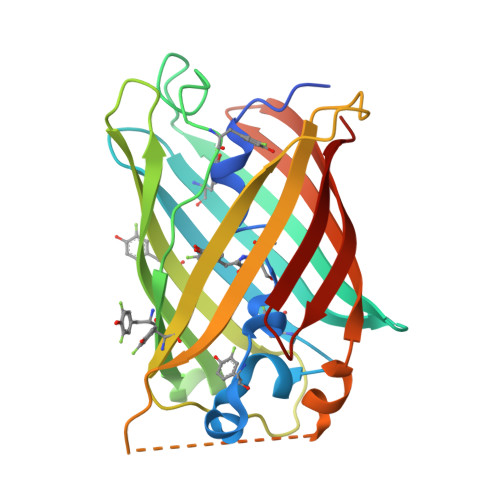Unusual Spectroscopic and Electric Field Sensitivity of Chromophores with Short Hydrogen Bonds: GFP and PYP as Model Systems.
Lin, C.Y., Boxer, S.G.(2020) J Phys Chem B 124: 9513-9525
- PubMed: 33073990
- DOI: https://doi.org/10.1021/acs.jpcb.0c07730
- Primary Citation of Related Structures:
6OG8, 6OG9, 6OGA, 6OGB, 6OGC, 6UN5, 6UN6, 6UN7 - PubMed Abstract:
Short hydrogen bonds, with heavy-atom distances less than 2.7 Å, are believed to exhibit proton delocalization, and their possible role in catalysis has been widely debated. While spectroscopic and/or structural methods are usually employed to study the degree of proton delocalization, ambiguities still arise, and no direct information on the corresponding potential energy surface is obtained. Here, we apply an external electric field to perturb the short hydrogen bond(s) within a collection of green fluorescent protein S65T/H148D variants and photoactive yellow protein mutants, where the chromophore participates in the short hydrogen bond(s) and serves as an optical probe of the proton position. As the proton is charged, its position may shift in response to the external electric field, and the chromophore's electronic absorption can thus reflect the ease of proton transfer. The results suggest that low-barrier hydrogen bonds (LBHBs) are not present within these proteins even when proton affinities between donor and acceptor are closely matched. Exploiting the chromophores as precalibrated electrostatic probes, the covalency of short hydrogen bonds as a nonelectrostatic component is also revealed. A theoretical framework is developed to address a possible contribution of unusually large polarizabilities of short hydrogen bonds due to proton delocalization, but no clear evidence for this phenomenon is found in accordance with the absence of LBHBs.
Organizational Affiliation:
Department of Chemistry, Stanford University, Stanford, California 94305, United States.



















